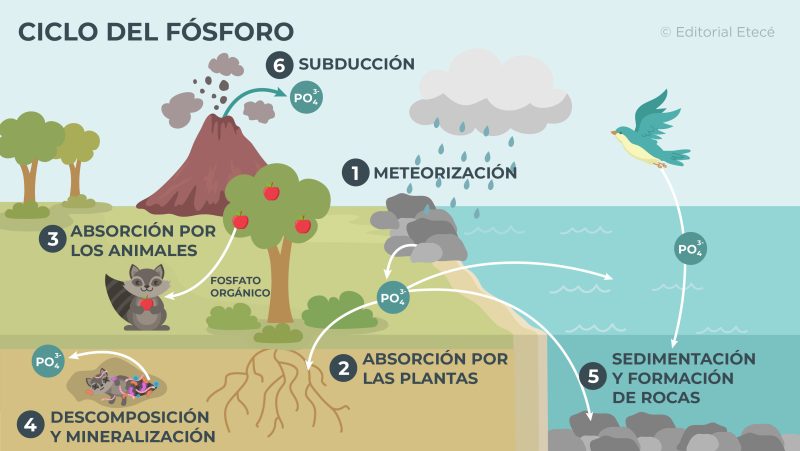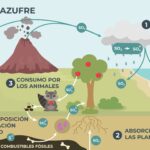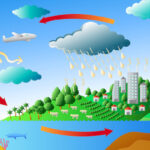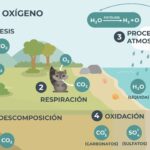We explain what the phosphorus cycle is, its characteristics and stages. Also, the importance of this biogeochemical cycle for life.

What is the phosphorus cycle?
The biogeochemical phosphorus (P) cycle is the circulation of phosphorus on planet Earth. Through this cycle, Phosphorus is transported between different ecosystems and their environment.
Phosphorus moves, forming part of different chemical compounds, between living beings, the lithosphere and the hydrosphere. Because phosphorus does not form volatile compounds, it is very difficult for it to move from water (from rivers, seas and oceans) to the atmosphere, which makes this cycle relatively slow.
Besides, Phosphorus is a fairly scarce nutrient and it is transferred between different living beings through food chains (the process of transferring nutrients between different species that eat each other). In addition, this element is part of many biomolecules essential to sustaining life, such as phospholipids, which are molecules found in cell membranes.
See also: Phosphorus
Features of the phosphorus cycle
The phosphorus cycle is characterized by the following aspects:
- It's a slow cycle One of the main characteristics of the phosphorus cycle is related to the fact that phosphorus does not form volatile compounds, which makes this cycle slower than other biogeochemical cycles, such as that of carbon or oxygen.
- Phosphorus is not transported to the atmosphere Since it is not made up of volatile compounds, phosphorus cannot be transported from water into the atmosphere and then fall to land.
- Flying animals guarantee the transport of phosphorus from water to land One of the ways phosphorus is transferred from water to land is through bird droppings, which when they fly and excrete, disperse phosphorus over the surface of the land.
- It is also energized by human beings Man can also transport phosphorus to the earth by excavating rocks that contain phosphates.
See also: Biogeochemical cycles
Stages of the phosphorus cycle
The different stages of the phosphorus cycle are:
- Weathering. Rocks and minerals that contain phosphorus as part of phosphate ions (PO43-), and which are located in the Earth's crust, they can be decomposed by the action of wind, rain, temperature and other erosive agents. In this way, phosphorus can be released into the soil.
- Absorption by plants Plants incorporate phosphorus present in the soil (in the form of phosphates (PO43-) through its roots.
- Absorption by animals Phosphorus can be incorporated into different types of animals when they consume plants (in the case of herbivorous animals), and when they consume other animals (in the case of carnivorous animals).
- Decomposition and mineralization When plants and animals die, they decompose and the phosphorus they contain in their bodies is released into the soil and water.
- Sedimentation and rock formation Phosphorus accumulated in the form of inorganic phosphates at the bottom of lakes, rivers and seas sediments and is compressed to form phosphate rocks.
- Subduction. During volcanic activity, phosphorus present in sunken plates can return to the Earth's surface.
Importance of the phosphorus cycle
The phosphorus cycle is of vital importance for maintaining life on the planet, since Phosphorus is part of the DNA of living organisms. In addition, phosphorus is a fundamental part of the structure of cell membranes and ATP (adenosine triphosphate), which is the main molecule that transfers energy to cells.
On the other hand, the correct functioning of the phosphorus cycle impacts plant growth which in turn influences the size of the flowers and fruits. For this reason, phosphorus is used to produce fertilizers.
In addition, phosphorus is used as a raw material in the food industry to produce anti-caking agents. It is also used to produce elements that emit light, matches, detergents and metal alloys.
Alterations in the phosphorus cycle due to human impact
Human beings have influenced the biogeochemical cycles of different chemical elements in different ways, and their intervention in the phosphorus cycle is no exception. Phosphorus levels on the earth's surface have increased due to mining activity, since man has extracted phosphorus from rocks using artificial processes which if they occurred naturally due to erosion, would take thousands of years.
On the other hand, the use of fertilizers on crops, which are then washed by water and drained into natural water reservoirs, causes an increase in phosphorus in rivers, lakes and seas. Furthermore, since phosphorus is a nutrient, its increase in the different natural water deposits causes the excessive growth of algae and microorganisms, which consume a lot of dissolved oxygen and do not allow the fish to breathe normally, causing them to die. This excessive increase in algae and microorganisms due to excess nutrients is called “eutrophication”.
References
- Picone, L., & Zamuner, E. (2002). Organic phosphorus and phosphoric fertility. Agronomic information of the southern cone, 16(7620), 11-15.
- Romañà, J. (1993). Study of the phosphorus cycle in fast-growing forest plantations (Doctoral dissertation, University of Barcelona).
- Fernández, MT (2007). Phosphorus: friend or enemy. ICIDCA. About Sugar Cane Derivatives, 41(2), 51-57.
- Cerón Rincón, LE, & Ancízar Aristizábal Gutiérrez, F. (2012). Dynamics of the nitrogen and phosphorus cycle in soils. Colombian Biotechnology Magazine, 14(1), 285-295.





